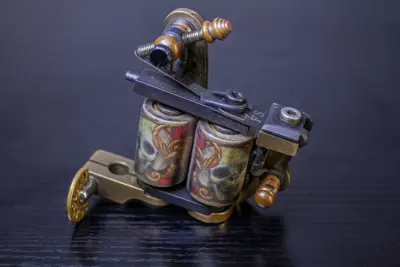Three-etch Needle
Handy little thing. Watching a doctor 'write' a wound closed is pretty interesting...
Three-etch needles are often considered a healer or technomage's best friend, depending on who was asked. This uncommon hand-held device is not just a writing tool but also a sculpting tool. The sculpting material varies based on the person using the instrument and the purpose of what's to be written.
Technomages and gadgeteers use the device to craft or etch Rune-Keys to power a device or spell. Doctors and other healers use three-etch needles to deal with more delicate wounds. They do this by writing a Patch-mod on a patient to close wounds or to replace or enhance body parts.
Some advice... if you hear the hum of a three-etch stop and a gadgeteer says 'uh oh'? Run.
Sketchy Origins
Neutron stones have been used throughout history to enhance a spell or enchanted item. The first designs for a mechanical means to 'write' out a rune-key onto a stone or other surface come from the legendary wizard and gadgeteer, Morganaine Sereno, in the late 2nd and early 3rd ages.
Morganaine's original designs called for a quill and needle arrangement using an enchanted cord to draw off neutron stone powder along with prepared potions and elixirs. This design had been put into use for some number of years in certain areas but was not very portable. Also, the components were expensive or difficult to craft.
Over time, different versions of Morganaine's idea have surfaced. They were primarily focused on enchantment and item crafting by ancient wizards, enchanters, and alchemists. It wasn't until the 5th Age that the tool saw its use expand into the healing profession.
In the years before the Final War, the three-etch needle was a primary component in the 'replicator' technology that was common at the height of the Coalition of Worlds. Records show that these devices, using three-etch needles, could craft far more than just rune keys. Tools, clothing, and more were only some of the items created by three-etch needles in a replicator device.
The plans and means to make replicators was lost during the Final War as were the three-etch needles of that day. Current day three-etch needle design is from studying a combination of destroyed replicators, 5th Age records, and Morganaine's surviving original designs.
Most amazing is the mention of food. They had some way to use their 'replicators' and three-etch needles to actually 'write' out things like a nice cup of tea. Not the cup, but the tea!
Mechanics & Inner Workings
A three-etch needle is held like any quill or pen, but most healers recommend wearing a glove or other protection when using the device. The frame that holds the quartz cylinders is the strongest part in case of accidental leaks which can be explosive. Owners often add padding to part of the frame resting on their hand.
The device is powered with a pair of small fire and stone shaper rune-keys. These propel the pump which draws off the cylinder ingredients. The flow volume of the ingredients is determined by the amount of pressure placed on the nib. If this isn't sufficient, a pressure switch at the base of the cylinders that can further adjust the flow volume.
Significance
Such a small, useful thing, but its connections across history... that is the astounding part for me.
The significance of the three-etch needle is often overlooked during daily life. Some may never see one if they live in a more rural area. But historians consider this type of device to be 'living history' since its design and concept can be directly traced back to one of history's greatest gadgeteers, the wizard Morganaine Sereno.
Also, this device is the only type that can enable the creation of a patch-mod for a subject. The ability of this tool to sculpt a net to close a wound but also write or draw a seam to attach an enhanced metal limb or spell effect onto a patient is unique.
Item type
Tool
Rarity
A three-etch needle is uncommon due to the need for powdered neutron stones as part of its 'ink'.
Weight
180 gram ( 6 ounces )
Dimensions
11.9 x 9.7 x 4.3 cm ( 4.7 x 3.8 x 1.7 inches )
Base Price
19 base-quartz on the average
Raw materials & Components
The main housing and frame are made from folded steel treated in an amber bath. This gives the metal protection and durability from breakage or extreme elements.
Silversteel is used for the nib. This gives the needle-shaped nib both flexibility to write smooth lines over different surfaces from bone to stone or skin.
Last would be the quartz cylinders. Three-etch needles come in a one or two cylinder variety. Rare models have been made up to four but beyond that it becomes too cumbersome to use. These cylinders house the powdered neutron stones, herbs, and tar ooze extract.
Tools
Most of a three-etch can be created at the shop of a skilled steelsmith with a flash-forge. A flash-forge is required to provide the proper heat when melding the folded steel with the amber from the liquid amber bath.
A glass-smith would have the forge and molds to make the quartz glass cylinders for the three-etch needle. The cylinders are a variant of the designs for a field alchemist's decanters.





Comments